Abstract
In today’s technological and stressful world, when everyone is busy in their daily routines and places blind faith in pharmaceutical advancements to protect their health, the sudden, horrifying effects of the COVID-19 pandemic have resulted in serious emotional and psychological impacts in the general population. In spite of advanced vaccination campaigns, fear and hesitation have become a part of human life since there are a number of people who do not want to take these immunity boosting vaccinations. Such people may become carriers of infectious viruses, leading to a more rapid rate of spread; therefore, this class of spreaders needs to be screened at the earliest opportunity. In this context, there is a need for advanced health monitoring systems which can assist the pharmaceutical industry to monitor and record the health status of people. To address this need and reduce the uncertainty of the situation, this study has designed and tested an Internet of Things (IoT) and Fog computing-based multi-node architecture was for real-time initial screening and recording of such subjects. The proposed system was able to record current body temperature and location coordinates along with the facial images. Further, the proposed system was able to transmit data to a cloud database using internet-connected services. An implementation and reviews-based working environment analysis was conducted to determine the efficacy of the proposed system. It was observed from the statistical analysis that the proposed IoT Fog-enabled ecosystem could be utilized efficiently.
1. Introduction
Today, due to the lack of a completely effective vaccine against COVID-19 virus and partial lifting of lockdowns globally, the pandemic situation is becoming more severe and is affecting people emotionally and psychologically, which is also leading to corona phobias among many people. Wuhan, China is considered the first epicenter of the COVID-19 virus, and due to its airborne nature and global spread, the number of infected cases and the number of deaths due to COVID-19 are still increasing day by day [1,2,3,4]. The main cause of spread is considered to be a lack of accurate detection measures, data storage and possible cure for the novel coronavirus. The symptoms of COVID-19 infections are usually fever, cough, sore throat, breathlessness, fatigue, and malaise among others [4]. Due to the human-to-human transmission mode, the number of cases started increasing exponentially [1,5]. The fear and anxiety associated with COVID-19 resulted from its rapid spread, a lack of authenticated knowledge, a large number of reported deaths and a lack of specific initial treatment and screening of COVID-19 patients [5,6,7]. Panic in the global population increased with partial lifting of lockdowns all over the world, since a large part of the population have asymptomatic novel coronavirus and are sometimes almost unaware of their health situation. Such asymptomatic subjects become super spreaders, and another wave of the COVID-19 pandemic might prove destructive to the human race.
The process of lifting lockdowns should be intelligent enough to accurately detect and track the potentially infected patients throughout the particular nation. The major initial symptoms of COVID-19 include fever, cough, sore throat, etc. and initial screenings could be performed by the measurement of body temperature in a safe contactless manner. A sudden rise in body temperature/high fever could be an initial indicator of COVID-19 used to determine a patient’s health status and this screening method has been adopted worldwide [8]. Sometimes, human error in screening could become a factor in the growth of an epidemic such as COVID-19. Technical or technological know-how was not available during early pandemics or epidemics such as Severe Acute Respiratory Syndrome (SARS), Asian Flu (1957), or the flu pandemic (1918) [9,10,11,12].
No doubt, health organizations around the globe and governments are doing everything possible to provide SARS-CoV-2 vaccinations to save humanity from this deadly virus and the pandemic situation. Regardless of such efforts, there is a certain probability that some people do not want to receive such lifesaving vaccines, and the resulting increased risk of virus spreaders/carriers becomes a concern. To diminish these risks an initial screening is required, but the initial screening needs to be smart enough to capture the complete information of such patients. This could assist health workers to take early decisions based on tracking and monitoring the patient from a distance. To enable such early interventions, the initial screening could be arranged at every point of entry and exit and at public gathering places, so that the unknown spreaders could be identified, and such screening requires a specially designed real-time monitoring system [13].
The work in the present paper describes the implementation of a specially designed device for monitoring the body temperature of a subject. The device provides an alert locally or remotely to a third party if the body temperature of the subject is determined to be abnormal. The data from the initial screening of the general population would become large to require the use of the cloud system to store the information of all screening subjects.
The fog and cloud-based device could measure the body temperature of the subjects without contact with the skin and store the data on an internet-based secure server for further analysis. In addition, the facial recognition algorithm could detect and store the biometric information of subjects, which could be further matched with a secure local government database. Access could then be given to authorized health workers to track the records of particular subjects identified as virus spreaders during emergency situations such as the COVID-19 pandemic. Trends in the stored database of detected persons could also be analyzed on a regional basis to inform broader preventive measures. The contributions of the present study include:
- Design of the IoT-Fog Computing-Based Multi-Node (FCMN) Architectural Framework for Real Time Health Monitoring;
- Real-time analysis of the proposed FCMN-based real time health monitoring framework;
- Statistical analysis for the validation of the proposed health monitoring framework.
Further, the paper is divided into different sections as follows. Section 2 reviews the detailed studies related to the proposed work and also presents the general methodology, which addresses currents needs in the area of health monitoring and IOT. The proposed FCMN-based health monitoring system is explained in Section 3 along with a performance analysis and evaluation of the results. The conclusion and future of the present work are discussed in Section 4.
2. Related Study and General Methodology
The revolution in technology and innovations such as internet services, smart phones, smart gadgets and the emergence of fifth-generation internet services has enabled health workers and professionals to provide online health services and analyze patients’ records online through cloud storage [11,12,14,15]. The trend analysis of the health records of a particular geographical region, particular disease or particular patient, could be possible and further, predictions could be made with the advancement of technologies. Utilizing affective computing and advanced electronic physiological sensors, cameras, locating devices etc., machines could be able to adapt to different human states and perform diagnosis-related activities without human-initiated errors [14,15,16]. Such high-level computing and communication machines could collect health related data 24 × 7 and further, data analysis could be performed on analytical platforms.
Most researchers in this area have efficiently utilized infrared based thermometers to measure human body temperature in real time [17,18,19]. A fog computing-based facial identification system was deployed in an industrial environment by Hu, et al. [20], who implemented a local binary patterns-based algorithm over a cloud connected Fog system. Kumar et al. [21] proposed an IoT-connected image recognition and navigation-based assistive system for visually challenged people to support them with navigation. They also implemented a cloud and IoT based system to identify the sensory environment of autism impacted individuals and implemented an assistive system to reduce the impact of surrounding over sensitive inputs by providing alerts and feedbacks. Kaur & Sood [22] utilized an IoT-based framework for the surveillance of wildfire and a cloud system was implemented to store and analyze the collected data from internet connected sensors.
Kaur et al. [23] focused on Internet of Things (IoT) based applications along with fog computing for monitoring, collection of data and proper analysis of collected data in drought areas. The collection and analysis parameters included humidity, temperature, soil moisture and groundwater. The data was collected remotely with the help of IoT-based modules and the analysis for drought prediction was performed efficiently. Javed et al. [24,25,26] analyzed human body temperatures through a sensor-based IoT system in a heat stroke scenario. They utilized a specially designed sensor-based wristband to measure changes in body temperature, and the device issued an alert to the caregivers regarding adverse case conditions. Kshirsgar et al. [27] utilized a sensor-based IoT and cloud system for managing the most sensitive Neonatal Intensive Care Unit (NICU) and implemented various sensors for measuring and controlling the humidity, temperature, and heart rate of the patients. The patients’ health conditions were also analyzed through IoT and cloud-connected systems. A heart rate and body temperature measurement system along with an error sensing technique was developed by Wijaya et al. [28] and achieved an error of less than 0.55 percent. Handheld devices, mobile technologies and multi-location architectures have played vital role in the implementations of disease detection technologies [29,30,31,32].
It is necessary to closely monitor the anonymous spread of the present COVID-19, especially when an individual is unaware of their infection and could spread the virus unknowingly. Real time monitoring is essential to stop such infections from spreading, and the real time internet-connected cloud-based monitoring and recording of data related to human subjects such as body temperature, facial image, location of capture, etc., could be considered as the need of the hour. Such monitoring could also be required at different locations where people gather in larger numbers. Figure 1 illustrates the proposed general methodology where monitoring at different venues and locations connected to a centralized cloud database server could be utilized to provide remote monitoring and analytics about the health of the screened individuals.
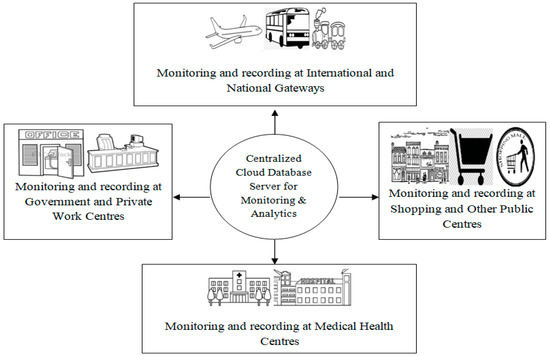
Figure 1.
General methodology.
3. Proposed System
As COVID-19 continues to threaten global populations with its rapid transmission, the prototype of a specifically-designed assistive technology is proposed. This technology could record and transmit human body temperatures in a contactless manner, collect the facial images of the same human subjects and identify the global positioning satellite (GPS) location of the subjects. The fog-based record could be stored on a local server for immediate analysis and simultaneously, the design of the proposed system has the capability to transmit and store the data in the cloud database through fog computing architecture for future monitoring and analysis. The conceptual diagram and workflow of the proposed system is presented in Figure 2. To meet the need of the hour, the proposed system could be installed at various locations through fog-based multi-node architecture and further, the monitoring and analysis could be performed by health-workers at a distance through the cloud storage.
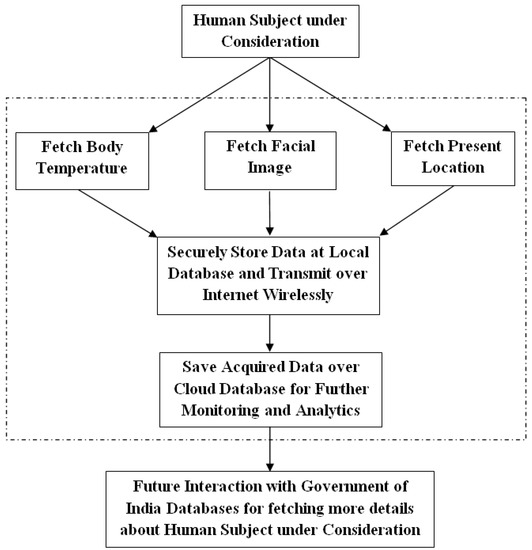
Figure 2.
Conceptual diagram for proposed system.
The design architecture of the proposed system is divided into three stages: the Fog Computing-based Single Node (FCSN) architecture, the hardware design of FCSN, and the Fog Computing-based Multi-Node (FCMN) architecture. The detailed discussion of the platform aims to understand the work flow of a single node and the interface circuitry with other components. Further, the hardware design and interface requirements for the FCSN architecture of the proposed system are crucial to understanding its proper implementation. Finally, to reduce the technical or human errors in recording and tracking the health conditions of the patient/subjects, the FCMN architecture is proposed.
3.1. Fog Computing-Based Single Node (FCSN) Architecture
The work flow of the FCSN architecture of the proposed system is presented in Figure 3. The FCSN node is designed to collect human body temperatures, a facial image and GPS location through a specially designed hardware interface. The hardware interface of the proposed FCSN is presented in Figure 4. Human body temperatures are collected through a thermal and infrared-based contactless temperature sensor and high-definition facial images are collected using a five megapixels web camera. The data collection and wireless transmission are controlled by a Raspberry Pi 3 microcomputer. A 7-inch LCD display screen is attached to the Raspberry Pi 3, which is capable of displaying the subjects’ body temperatures, facial image and current location coordinates of the data collection venue using a GPS module. The captured health and social data is then stored on the local server. The tabular structure of the local storage database which includes a serial-number, body temperature, facial image, date-time and GPS location, is presented in Figure 4. The serial number is an auto-generated number on the local system. The body temperature, facial image and GPS location are provided by the attached hardware device, and the date-time is provided by the local Fog system. Before storing in the local database, public key data encryption is implemented on the recorded data.
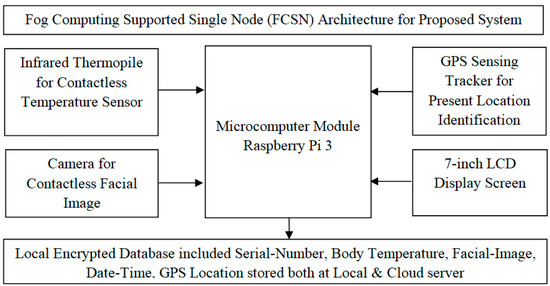
Figure 3.
Architecture of proposed fog computing supported single node (FCSN).
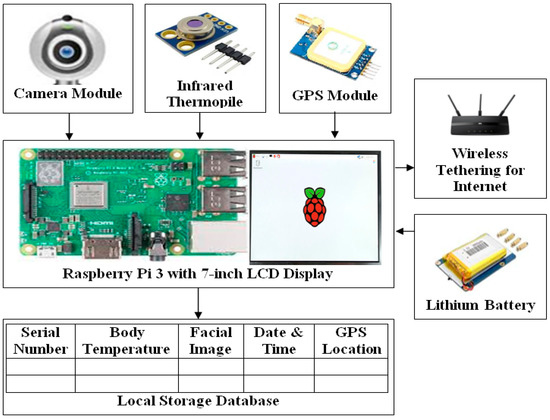
Figure 4.
Hardware architecture of fog computing supported single node (FCSN).
3.2. IoT-Fog Computing Supported Multi-Node (FCMN) Architecture
The proposed system could be very effective in the current outbreak of COVID-19 and also useful in monitoring health on a regional basis, during epidemic disease outbreaks or at a patient level. Almost, the whole world has been in long lockdown conditions to control the spread of the deadly COVID-19 virus. However, it is essential that after the end of the lockdowns, the COVID-19 patients or unknown spreaders are identified, properly tracked and monitored. The multi-node architecture of the proposed system could be able to perform the initial screening at various locations, and store the social facial image and GPS location of the particular subject. The FCMN architecture is the combination of connected 1-to-N FCSN nodes located at various locations.
The conceptual workflow of the FCMN architecture of the proposed system is presented in Figure 5. The initial screening data, such as body temperature, facial image and GPS location is encrypted and transmitted by individual FCSN nodes in real-time to an internet-connected cloud database server. The remote monitoring system for the assigned health-worker or government authorities could also be implemented for real time monitoring of health record trends of particular geographical regions, epidemic diseases or particular patients. The travel track of a specific subject or patient could also be monitored through the facial image match algorithm and the health data of the patient together with GPS coordinates could be stored in a cloud database with the date and time of the data records, while maintaining appropriate privacy protection of the data. The hardware connectivity and detailed architecture of FCMN is presented in Figure 6. In the present work, the student and research access version of the software named “Tableau Software” [33] was utilized.
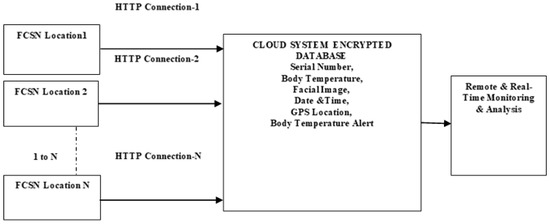
Figure 5.
IoT-fog computing-based multi-node (FCMN) architecture.

Figure 6.
Detailed hardware interfacing of FCMN architecture.
3.3. Working Methodology
To meet the requirements for the current need-of-the-hour initial screening, N-number of FCSN systems could be implemented at N-number of different locations to perform screening. The N-FCSN systems could store the health data of the subject and further transmit the encrypted version to a wireless-connected cloud database server. The detailed flow of the working methodology for the proposed system is presented in Figure 7. The step-by-step procedure is as follows:
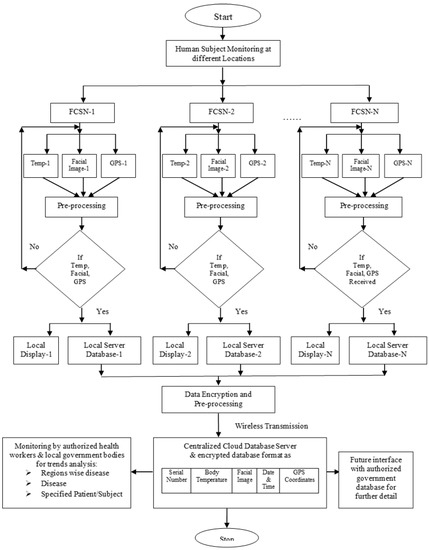
Figure 7.
Working methodology of the proposed system.
- Step 1
- Installation of N-FCSN system nodes at N-locations
- Step 2
- At different locations, health and social data is fetched by each FCSN system node with click buttons provided such as:
- Fetch social data as a facial image by contactless means through the attached camera with FCSN.
- Fetch human body temperature by contactless means using an infrared thermopile attached with FCSN.
- Fetch present location of screening using GPS locating sensor attached with FCSN where facial image and temperature were fetched.
- Step 3
- Thereceived data is pre-processed and if the proper data cannot be fetched at a particular FCSN node location, then Step-2 is repeated at the respective location.
- Step 4
- The fetched data is displayed on the local display screen with each FCSN and also stored on the local database server in the prescribed format.
- Step 5
- The received data is then encrypted to secure transmission and pre-processing is performed to remove any redundancy.
- Step 6
- Transmission of encrypted data from FCSNs deployed at different locations to cloud databases using a wireless internet connection.
- Step 7
- At the centralized cloud database server, the social facial image, health data and location of capture are stored for run time monitoring and analysis by the authorized health worker and local government officials.
4. Results Analysis
The real-time performance of the proposed multi-node-based health monitoring system is evaluated in this section. The real-time evaluation included the real-time data collection at different locations, pre-processing, comparative analysis and statistical analysis of the proposed device.
4.1. Data Collection and Analysis
For the evaluation of the proposed health monitoring framework, real-time data collection played a vital role. During real-time data collection, the anonymous subjects were monitored at four different places both public and private including a work center, a shopping complex, a bus terminal and a medical center, as shown in Figure 1. The monitoring was performed at the entry points of all the data collection venues. The test dataset included the body temperature of 5278 subjects of all ages along with facial images and GPS locations of the respective subjects. During the process of data collection, both the proposed FCMN-based monitoring system and standard market available devices were utilized and a selection of the data at different locations is presented in Table 1. The measurement errors due to human negligence were removed during pre-processing of the data. Further, it was observed from the comparative analysis of received data as presented in Table 1 that the proposed health-monitoring framework worked with a minimal amount of error, as presented in Table 2. The graphical analysis of the proposed monitoring device is presented in Figure 8.

Table 1.
Data collected at different locations.

Table 2.
Analysis of proposed system.
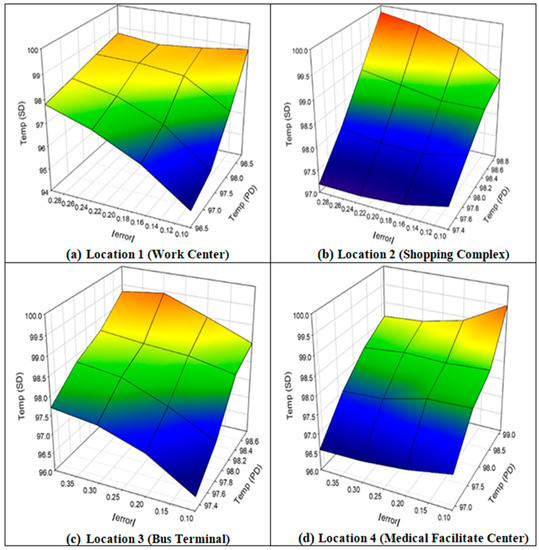
Figure 8.
Comparative analysis of proposed monitoring device with standard device at four different locations.
In the FCMN-based proposed monitoring system, the subject-specific data is stored on a cloud server as serial number, body temperature, facial image, date and time along with the GPS location of the subject. The privacy of the health data was taken into consideration and the received data was encrypted while stored on the cloud server. The continuous updating of the database of respective subjects helped to monitor subjects who have a regular increase in body temperature and continue to move around in public locations. This provision of the proposed framework could help the government health workers to take necessary measures to control such activities and provide proper medications to the subjects. In addition, using the proposed health monitoring framework, the authorized health workers and local government bodies could obtain a comparative day-by-day analysis of the disease trends on the basis of region, state or specific subjects, as presented in Figure 7.
4.2. Statistical Analysis of User Satisfaction
The performance of the proposed health monitoring system was also analyzed statistically from the perspective of device users. For this evaluation, a real-time analysis of users’ reviews was conducted to determine the views of users with different knowledge levels, such as Graduates (Technical), Graduates (Non-Technical), Undergraduates (Technical), and Undergraduates (Non-Technical). The analysis was performed based on a questionnaire which included questions related to the handheld device, temperature measurements, location identifications, facial image utilization, data recording, and data visualization. All the survey activities were conducted in accordance with the regulations of the local Government of Punjab (India) and national (Government of India) governments, such as social distancing, sanitizing, face masks, etc. The demographic characteristics of participating individuals are presented in Table 3. The observations recorded are presented in Table 4. Further, a statistical analysis was performed and is presented in Table 5.

Table 3.
Demographic characteristics of participants.

Table 4.
Surveyed outcomes of proposed system.

Table 5.
Statistical analysis of surveyed outcomes.
4.3. Discussion
The performance of the proposed IoT-Fog FCMN-based health monitoring system was compared with the standard market available devices to measure body temperature. The results of the evaluation are presented in Table 3 and Figure 8. The results show that the measurements of both devices were satisfactory with minimum errors. The proposed device was also found to be satisfactory in identifying GPS locations at different locations and also accurately captured facial images of the subjects under consideration. The device was found to be proficient in transmitting data to internet connected server immediately after fetching the temperature, location and facial images. The user experience while using the proposed framework was also captured during the evaluation process and the observations are presented in Table 4 and Table 5. The results based on different user satisfaction parameters were found to be satisfactory. Around 92 % of participants gave an above average grading, which means more than 5 on a scale of 0 to 10, and the overall average was 6.47 on the scale of 0 to 10. Further, the statistical parameters presented in Table 4 were are positioned on the positive side of the proposed system with overall standard deviation, SD = 0.81 and Mean = 6.47 for the observed mean values with respect to individual participants. Symbols and notations are mentioned in Table A1.
5. Conclusions and Future Work
When the spread of deadly viruses such as COVID-19 create widespread global concern, smart and assistive technologies could provide some relief in the detection, diagnosis and medication of infected people. The proposed FCMN-based health monitoring system could be used efficiently for monitoring initial health parameters irrespective of the subject’s negligence or insufficient knowledge about epidemic diseases such as the COVID-19 virus. If mass initial screening could be performed by the proposed system, then social and health data could be stored on a centralized cloud server. If infected patients then mislead health workers concerning their health status, the patients’ travel activities could be monitored with multiple screenings at various locations that are equipped with the proposed system and are visited by subjects. Additionally, the human error in performing the initial screening could also be reduced. If the proposed system could be implemented at various locations and continuous screening was performed, then the health worker could also perform a trend analysis based on stored health data and could predict irregular/atypical temperature trends on a region or patient basis. The health worker could also predict the outbreak of some unknown diseases from the recorded temperature trends. The hidden patients with a particular disease could also be tracked by the proposed system. In the future, the proposed system could also assist with the identification of unknown intruders in the country by immediate health screening and further social image matching with available government databases. Since the proposed system has the capability to record the social facial image of citizens, it could be helpful in population registration using available government-issued identity cards.
Author Contributions
Conceptualization, V.K., N.K.; methodology, V.K., H.P.S.; investigation, Y.M., H.P.S., D.G.; data curation, Y.M., D.A., N.K.; writing—original draft preparation, V.K., H.G.M., N.G.; writing—review and editing, N.G., D.G., N.K.; visualization, N.G., H.P.S., D.G.; supervision, Y.M., D.A.; funding acquisition, H.G.M., Y.M. All authors have read and agreed to the published version of the manuscript.
Funding
Princess Nourah bint Abdulrahman University Researchers Supporting Project number (PNURSP2022TR140), Princess Nourah bint Abdulrahman University, Riyadh, Saudi Arabia.
Data Availability Statement
Data is available on request from first author.
Acknowledgments
Princess Nourah bint Abdulrahman University Researchers Supporting Project number (PNURSP2022TR140), Princess Nourah bint Abdulrahman University, Riyadh, Saudi Arabia.
Conflicts of Interest
The authors declare no conflict of interest.
Appendix A

Table A1.
Table of Symbols and Notations.
Table A1.
Table of Symbols and Notations.
| Sr No | Symbol or Notation | Detail |
|---|---|---|
| 1 | IoT | Internet of Things |
| 2 | SARS | Severe Acute Respiratory Syndrome |
| 3 | FCMN | Fog Computing Based Multi Node |
| 4 | NICU | Neonatal Intensive Care Unit |
| 5 | GPS | Global Positioning Satellite |
| 6 | FCSN | Fog Computing based Single Node |
| 7 | PD | Proposed Device |
| 8 | SD | Standard Device |
| 9 | ABS | Absolute |
| 10 | G(T) | Graduates (Technical) |
| 11 | G(NT) | Graduates (Non-Technical) |
| 12 | UG(T) | Under Graduates (Technical) |
| 13 | UG (NT) | Under Graduates (Non-Technical) |
| 14 | CG | Caregiver Group |
| 15 | TM | Temperature Measurement |
| 16 | HE | Handling Easiness |
| 17 | LI | Location Identification |
| 18 | FIU | Facial Image Utilization |
| 19 | DR | Data Recording |
| 20 | DV | Data Visualization |
| 21 | SD | Standard Deviation |
References
- Adhikari, S.P.; Meng, S.; Wu, Y.-J.; Mao, Y.-P.; Ye, R.-X.; Wang, Q.-Z.; Sun, C.; Sylvia, S.; Rozelle, S.; Raat, H.; et al. Epidemiology, causes, clinical manifestation and diagnosis, prevention and control of coronavirus disease (COVID-19) during the early outbreak period: A scoping review. Infect. Dis. Poverty 2020, 9, 1–12. [Google Scholar] [CrossRef] [PubMed]
- Wu, D.; Wu, T.; Liu, Q.; Yang, Z. The SARS-CoV-2 outbreak: What we know. Int. J. Infect. Dis. 2020, 94, 44–48. [Google Scholar] [CrossRef] [PubMed]
- Anzai, A.; Kobayashi, T.; Linton, N.M.; Kinoshita, R.; Hayashi, K.; Suzuki, A.; Yang, Y.; Jung, S.-M.; Miyama, T.; Akhmetzhanov, A.R.; et al. Assessing the Impact of Reduced Travel on Exportation Dynamics of Novel Coronavirus Infection (COVID-19). J. Clin. Med. 2020, 9, 601. [Google Scholar] [CrossRef] [PubMed]
- Aiyegbusi, O.L.; Hughes, S.E.; Turner, G.; Rivera, S.C.; McMullan, C.; Chandan, J.S.; Haroon, S.; Price, G.; Davies, E.H.; Nirantharakumar, K.; et al. Symptoms, complications and management of long COVID: A review. J. R. Soc. Med. 2021, 114, 428–442. [Google Scholar] [CrossRef]
- World Health Organization. Coronavirus Disease (COVID-2019) Situation Reports. Available online: https://www.who.int/emergencies/diseases/novel-coronavirus-2019/situation-reports (accessed on 5 May 2022).
- Government of India. COVID-19 Tracker INDIA. Available online: https://www.mygov.in/covid-19 (accessed on 10 May 2022).
- Dong, E.; Du, H.; Gardner, L. An interactive web-based dashboard to track COVID-19 in real time. Lancet Infect. Diseases 2020, 20, 533–534. [Google Scholar] [CrossRef]
- Durankuş, F.; Aksu, E. Effects of the COVID-19 pandemic on anxiety and depressive symptoms in pregnant women: A preliminary study. J. Matern. Neonatal Med. 2020, 35, 205–211. [Google Scholar] [CrossRef]
- Kwon, J.; Azad, A. More than 140 seemingly recovered patients have retested positive for Covid-19, says South Korea. CNN Health News, 16 April 2020. [Google Scholar]
- Liu, S.; Yang, L.; Zhang, C.; Xiang, Y.-T.; Liu, Z.; Hu, S.; Zhang, B. Online mental health services in China during the COVID-19 outbreak. Lancet Psychiatry 2020, 7, E17–E18. [Google Scholar] [CrossRef]
- Polas, M.R.H.; Raju, V. Technology and Entrepreneurial Marketing Decisions During COVID-19. Glob. J. Flex. Syst. Manag. 2020, 22, 95–112. [Google Scholar] [CrossRef]
- Intawong, K.; Olson, D.; Chariyalertsak, S. Application technology to fight the COVID-19 pandemic: Lessons learned in Thailand. Biochem. Biophys. Res. Commun. 2021, 534, 830–836. [Google Scholar] [CrossRef]
- Menni, C.; Valdes, A.M.; Freidin, M.B.; Sudre, C.H.; Nguyen, L.H.; Drew, D.A.; Ganesh, S.; Varsavsky, T.; Cardoso, M.J.; El-Sayed Moustafa, J.S.; et al. Real-time tracking of self-reported symptoms to predict potential COVID-19. Nat. Med. 2020, 26, 1037–1040. [Google Scholar] [CrossRef]
- He, W.; Zhang, Z.; Li, W. Information technology solutions, challenges, and suggestions for tackling the COVID-19 pandemic. Int. J. Inf. Manag. 2021, 57, 102287. [Google Scholar] [CrossRef] [PubMed]
- Vargo, D.; Zhu, L.; Benwell, B.; Yan, Z. Digital technology use during COVID-19 pandemic: A rapid review. Hum. Behav. Emerg. Technol. 2021, 3, 13–24. [Google Scholar] [CrossRef]
- Ranjha, A.; Kaddoum, G. URLLC-Enabled by Laser Powered UAV Relay: A Quasi-Optimal Design of Resource Allocation, Trajectory Planning and Energy Harvesting. IEEE Trans. Veh. Technol. 2022, 71, 753–765. [Google Scholar] [CrossRef]
- Epstein, Y.; Moran, D.S. Extremes of temperature and hydration. In Travel Medicine, 4th ed.; Elsevier Inc.: Amsterdam, The Netherlands, 2019. [Google Scholar]
- Noyes, F.R.; Barber-Westin, S.D. Diagnosis and treatment of complex regional pain syndrome. In Noyes’ Knee Disorders: Surgery, Rehabilitation, Clinical Outcomes, 2nd ed.; Elsevier Inc.: Amsterdam, The Netherlands, 2017. [Google Scholar]
- Beyala, L. Comprehensive risk analysis process. In Connected Objects in Health; Elsevier Inc.: Amsterdam, The Netherlands, 2017; pp. 23–51. [Google Scholar]
- Hu, P.; Ning, H.; Qiu, T.; Zhang, Y.; Luo, X. Fog Computing Based Face Identification and Resolution Scheme in Internet of Things. IEEE Trans. Ind. Inform. 2017, 13, 1910–1920. [Google Scholar] [CrossRef]
- Kumar, P.M.; Gandhi, U.; Varatharajan, R.; Manogaran, G.R.; Vadivel, T. Intelligent face recognition and navigation system using neural learning for smart security in Internet of Things. Clust. Comput. 2019, 22, 7733–7744. [Google Scholar] [CrossRef]
- Kaur, H.; Sood, S.K. Fog-assisted IoT-enabled scalable network infrastructure for wildfire surveillance. J. Netw. Comput. Appl. 2019, 144, 171–183. [Google Scholar] [CrossRef]
- Kaur, H.; Sood, S.K. Cloud-Fog based framework for drought prediction and forecasting using artificial neural network and genetic algorithm. J. Exp. Theor. Artif. Intell. 2020, 32, 273–289. [Google Scholar] [CrossRef]
- Javed, S.; Ghazala, S.; Faseeha, U. Perspectives perspectives of heat stroke shield: An iot based solution for the detection and preliminary treatment of heat stroke. Eng. Technol. Appl. Sci. Res. 2020, 10, 5576–5580. [Google Scholar] [CrossRef]
- Kumar, A.; Sharma, S.; Goyal, N.; Singh, A.; Cheng, X.; Singh, P. Secure and energy-efficient smart building architecture with emerging technology IoT. Comput. Commun. 2021, 176, 207–217. [Google Scholar] [CrossRef]
- Dave, M.; Rastogi, V.; Miglani, M.; Saharan, P.; Goyal, N. Smart Fog-Based Video Surveillance with Privacy Preservation based on Blockchain. Wirel. Pers. Commun. 2022, 124, 1677–1694. [Google Scholar] [CrossRef]
- Kshirsgar, P.; More, V.; Hendre, V.; Chippalkatti, P.; Paliwal, K. IOT Based Baby Incubator for Clinic; Lecture Notes in Electrical Engineering; Springer: Berlin/Heidelberg, Germany, 2020; Volume 570, pp. 349–355. [Google Scholar]
- Wijaya, N.H.; Fauzi, F.A.T.; Helmy, E.; Nguyen, P.T.; Atmoko, R.A. The design of heart rate detector and body temperature measurement device using ATMega16. J. Robot. Control. 2020, 1, 40–43. [Google Scholar] [CrossRef]
- Ranjha, A.; Nguyen, T.N.; Javed, M.A. AECT: Accurate Energy Efficient Contact Tracing Using Smart Phones for Infectious Disease Detection. ACM Trans. Sens. Netw. 2022, 1–13. [Google Scholar] [CrossRef]
- Zhang, J.; Xiao, W.; Li, Y. Data and Knowledge Twin Driven Integration for Large-Scale Device-Free Localization. IEEE Internet Things 2021, 8, 320–331. [Google Scholar] [CrossRef]
- Khullar, V.; Singh, H.P.; Bala, M. Intelligent Handheld Expert System (HES) for Diagnosis of Autism Spectrum Disorder and its Severity Level. ASEAN J. Psychiatry 2018, 19, 12–26. [Google Scholar]
- Khullar, V.; Singh, H.P.; Bala, M. Deep Neural Network-based Handheld Diagnosis System for Autism Spectrum Disorder. Neurol. India 2019, 69, 66. [Google Scholar] [CrossRef]
- Tableau. Available online: https://www.tableau.com/support/releases/desktop/2020.1 (accessed on 5 May 2022).
Publisher’s Note: MDPI stays neutral with regard to jurisdictional claims in published maps and institutional affiliations. |
© 2022 by the authors. Licensee MDPI, Basel, Switzerland. This article is an open access article distributed under the terms and conditions of the Creative Commons Attribution (CC BY) license (https://creativecommons.org/licenses/by/4.0/).